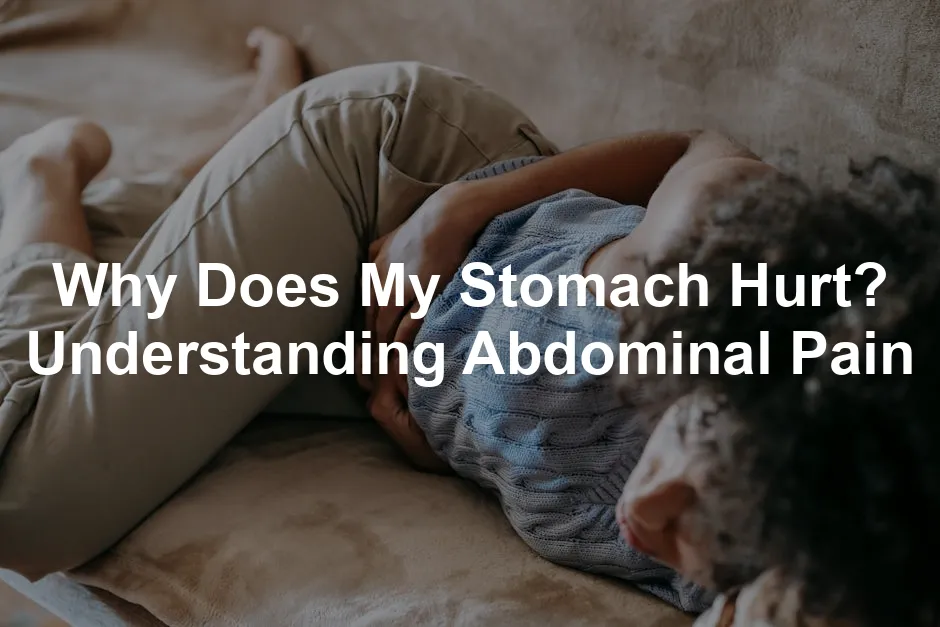
Why Does My Stomach Hurt? Understanding Abdominal Pain
Introduction
In the grand theater of our bodies, the stomach often takes center stage, performing a symphony of digestion and nourishment. But what happens when this vital organ decides to throw a tantrum? If you’ve ever found yourself clutching your belly in discomfort, you’re not alone. Stomach pain can be as perplexing as it is common. From mild indigestion to serious medical emergencies, the reasons behind a hurting stomach can vary widely.
Let’s face it: we’ve all had those moments when our stomachs seem to have a mind of their own. Maybe you indulged in one too many tacos, or perhaps your stress levels spiked before a big presentation. Whatever the cause, the result is often a painful reminder of just how sensitive our digestive systems can be.
In this article, we’ll sift through the symptoms, causes, and remedies that might just have you feeling better in no time! You’ll learn how to decode the messages your body is sending. Whether it’s a dull ache that lingers or a sharp pain that strikes without warning, understanding your abdominal pain is crucial. So buckle up, because we’re about to embark on a delightful journey through the curious world of tummy troubles.

Summary of Key Points
Abdominal pain can be categorized into several types, including acute, chronic, progressive, and intermittent. Each type has its own characteristics and potential causes. Let’s break it down:
- Definition of Abdominal Pain: Abdominal pain refers to discomfort in the area between the ribs and pelvis. It can originate from various organs, including the stomach, intestines, liver, and more.
- Common Types:
- Acute: Sudden and severe, often indicating a serious condition.
- Chronic: Lasting more than three months, potentially linked to ongoing issues.
- Progressive: Worsening over time, signaling serious health concerns.
- Intermittent: Pain that comes and goes, often related to specific triggers.
- Anatomy of the Abdomen: The abdomen houses vital organs, and pain can arise from any of them. Understanding the source helps pinpoint issues.
- Common Causes of Stomach Pain:
- Digestive Issues: Indigestion, gas, constipation, diarrhea, food allergies, and food poisoning can all lead to discomfort.
- Inflammation and Infections: Conditions like peptic ulcers, pancreatitis, gastroenteritis, and appendicitis can cause significant pain.
- Reproductive Issues: For individuals assigned female at birth, menstrual cramps, ovarian cysts, and ectopic pregnancies may be culprits.
- When to Seek Medical Help: Certain symptoms indicate serious conditions that require immediate attention, such as severe pain, persistent symptoms, or accompanying signs like fever or vomiting.
- Lifestyle Tips for Prevention and Management: Adopting healthy habits can mitigate stomach pain. Dietary suggestions, staying hydrated, and stress management play vital roles in digestive health.

Now that we’ve set the stage, it’s time to dive deeper into understanding stomach pain and its many causes. We’ll explore each category, so you can identify your discomfort and take action accordingly!
Understanding Stomach Pain
What is Abdominal Pain?
Abdominal pain refers to discomfort felt between the ribs and pelvis. It’s often described as a stomachache, but let’s not rush to conclusions. This pain can arise from various organs in the abdominal cavity, not just the stomach. Think of it as a group of rebellious organs throwing a collective fit!
So, what’s the difference between stomach pain and abdominal pain? Stomach pain is localized, usually linked to issues within the stomach itself. In contrast, abdominal pain can stem from different organs, like the intestines, liver, or gallbladder. This distinction is crucial for pinpointing the problem.
Healthcare professionals categorize abdominal pain into two main types: generalized and localized. Generalized pain affects a larger area and can indicate widespread issues, like a stomach virus. Localized pain, on the other hand, is more specific and typically points to a problem with a particular organ. Knowing whether your pain is generalized or localized can help guide your diagnosis and treatment.

Types of Abdominal Pain
Abdominal pain is not one-size-fits-all. It comes in different forms, each with its own story to tell.
- Acute Pain: This is the drama queen of abdominal pain. It strikes suddenly and can be quite severe. Acute pain often indicates serious conditions, like appendicitis or gallbladder issues. If you experience this, don’t wait for the curtain call—seek help!
- Chronic Pain: This is the persistent character, lingering for three months or more. Chronic pain may stem from ongoing issues like irritable bowel syndrome (IBS) or inflammatory bowel disease (IBD). It can disrupt your life and may require long-term management.
- Progressive Pain: This pain isn’t just dramatic; it’s also escalating. If your pain worsens over time, it could signal serious health concerns. Watch for accompanying symptoms to determine if you need medical attention.
- Intermittent Pain: The comeback kid! This type of pain comes and goes, often triggered by specific factors, such as certain foods or activities. It can be frustrating but may not always indicate a serious condition.
Recognizing these types of abdominal pain can help you better understand your body’s signals. It’s like having a backstage pass to the show of your health!

Common Causes of Stomach Pain
Digestive Issues
Next, let’s navigate the common culprits behind that pesky stomach pain.
- Indigestion: Often caused by overeating or eating too quickly, indigestion can lead to bloating, discomfort, and a burning sensation in the stomach. Remedies include smaller meals and avoiding trigger foods.
- Gas and Bloating: Trapped air is a common nuisance. It can be influenced by your diet—think beans, carbonated drinks, and certain vegetables. To ease your discomfort, try gentle exercises, or simply walk it off! You might also consider keeping some Gas-X Extra Strength Softgel on hand to alleviate that bloated feeling!
- Constipation: A slow-moving digestive system can lead to discomfort and bloating. Symptoms include infrequent bowel movements and straining. We all know the remedy: increase fiber and hydration! A Metamucil Fiber Supplement can help get things moving in the right direction.
- Diarrhea: This can be acute or chronic. Acute diarrhea often follows a stomach bug or food poisoning, while chronic diarrhea may signal underlying conditions like IBS. Staying hydrated is key, and you might consider bland foods to help settle your stomach. Don’t forget to stock up on Imodium A-D Diarrhea Relief Caplets for those unexpected tummy troubles!

Understanding these digestive issues can empower you to take charge of your health. With a little awareness, you can combat those stomach pains like a pro!
Inflammation and Infection
- Peptic Ulcers: These painful sores can develop on the stomach lining or the first part of the small intestine. Symptoms often include a burning sensation, nausea, and bloating. The notorious villain behind many ulcers is the H. pylori bacteria. Treatments usually involve antibiotics and medications to reduce stomach acid. So, if your stomach feels like it’s hosting its own horror show, it might be time to get checked!
- Pancreatitis: This inflammation of the pancreas can strike suddenly (acute) or linger (chronic). Symptoms include severe pain in the upper abdomen, often radiating to the back, along with nausea and vomiting. If you experience these symptoms, don’t wait for a miracle to happen—seek medical help! Early intervention can be lifesaving.
- Gastroenteritis (Stomach Flu): Ah, the infamous stomach flu! It’s a viral infection causing watery diarrhea, cramps, and vomiting. It can spread like wildfire through contaminated food or close contact with an infected person. Prevention is key! Wash your hands frequently, and avoid undercooked food. If you catch it, stay hydrated and let your tummy rest.
- Appendicitis: This condition is a classic “you need to act fast” scenario. The warning signs include sharp pain starting around the belly button, moving to the lower right abdomen, along with fever and nausea. If you suspect appendicitis, don’t hesitate—prompt treatment is crucial to avoid serious complications.

Reproductive Issues
- Menstrual Cramps: For many, that time of the month comes with a side of cramps. This discomfort happens as the uterus contracts to shed its lining. Management strategies include over-the-counter pain relievers, heat therapy, and gentle exercise. Don’t let cramps steal your thunder!
- Ovarian Cysts and Ectopic Pregnancy: Ovarian cysts can cause dull or sharp pain on one side of the abdomen. Ectopic pregnancy, where a fertilized egg grows outside the uterus, can lead to severe pain. Both conditions require medical attention. If you experience sudden, severe pain along with irregular bleeding, see a doctor right away!
Lifestyle Factors
Stress can wreak havoc on your digestive health. When life gets overwhelming, your stomach may respond with cramps or discomfort. Finding enjoyable ways to unwind, like yoga or meditation, can help keep your gut happy. A Yoga Mat for Stress Relief can provide the perfect space for your relaxation practices!
Dietary choices also play a significant role. Common food intolerances, like lactose and gluten, can lead to uncomfortable symptoms. Pay attention to how your body reacts to certain foods. Keeping a food diary might help you identify troublesome treats. And speaking of food, consider investing in Meal Prep Containers to help you organize your meals and keep those triggers at bay!
Hydration is crucial! Drinking enough water aids digestion and can prevent constipation. Regular exercise also encourages healthy gut function. So, lace up those sneakers and get moving—your stomach will thank you! And don’t forget to carry a Reusable Water Bottle to keep hydration at your fingertips!
By staying informed about these common causes of stomach pain, you can take proactive steps to protect your digestive health. Remember, your body is like a finely tuned instrument, and tuning it well can keep those pesky pains at bay!

When to Seek Medical Attention
Stomach pain can be tricky. Sometimes it’s just a bad burrito, but other times, it’s your body yelling for help. Knowing when to seek medical attention is crucial. Here are some signs to watch for.
Signs of Serious Conditions
If you experience severe abdominal pain that comes on suddenly, it’s time to pay attention. This kind of pain can indicate serious issues like appendicitis or pancreatitis. If the pain is persistent and doesn’t improve after a day or two, don’t hesitate to consult a healthcare provider. Other red flags include:
- Fever: A high temperature can signal an infection.
- Vomiting: Especially if you’re throwing up blood or something that looks like coffee grounds.
- Bloody stools: This could indicate bleeding in your digestive tract.
- Unexplained weight loss: If you’re shedding pounds without trying, get it checked out.
- Severe tenderness: If your abdomen hurts when you touch it, that’s not just a sign of too much pizza.

These symptoms could point to conditions like bowel obstruction, perforated ulcers, or even certain cancers. Don’t play the waiting game with your health; if something feels off, get it checked.
Importance of Immediate Care
Certain conditions require immediate medical intervention. For instance, appendicitis can escalate quickly. If the appendix bursts, it can lead to serious infections and complications. Similarly, pancreatitis can cause life-threatening issues if not treated urgently. Recognizing these conditions can be life-saving.
- Appendicitis: Look for pain starting around the belly button and migrating to the lower right abdomen. Add in nausea, vomiting, and a loss of appetite, and you’ve got a recipe for a trip to the ER.
- Pancreatitis: This sharp pain in the upper abdomen may radiate to the back. Nausea and vomiting often tag along. If you suspect pancreatitis, get help fast!
- Bowel Obstruction: This condition can cause severe pain and a swollen belly. You may also experience constipation or vomiting. It requires immediate care to avoid serious complications.

Communicating Symptoms Effectively
When you see a healthcare professional, clarity is key. Be prepared to describe your symptoms in detail. Here’s how to communicate effectively:
- Location of Pain: Specify where it hurts. Is it generalized or localized?
- Intensity: Rate your pain on a scale of 1 to 10. Is it a nagging ache or a sharp stab?
- Duration: How long have you been experiencing this pain? Did it come on suddenly or gradually?
- Associated Symptoms: Note any other symptoms, like nausea, fever, or changes in bowel habits.
- Triggers: Mention any food, activity, or stress that might have precipitated the pain.
By being a well-informed patient, you not only help your healthcare provider but also improve your chances of receiving timely, appropriate care. Remember, your body speaks, and it’s essential to listen when it’s asking for help!

Conclusion
In this exploration of abdominal pain, we’ve uncovered the complexity and often bewildering nature of stomach discomfort. While many causes are benign and self-limiting, it’s crucial to listen to your body and recognize when to seek help. By understanding the potential reasons for your stomach pain and adopting healthy lifestyle habits, you can take proactive steps towards better digestive health. Remember, the next time you find yourself asking, “Why does my stomach hurt?” you’ll have the tools to decipher your body’s signals.

FAQs
What are the most common causes of stomach pain?
Stomach pain can hit for various reasons, and it’s often related to your digestive system. Common culprits include indigestion, gas, and constipation. If you’ve ever felt that uncomfortable bloating after a big meal, you’ve experienced one of these digestive issues firsthand. Inflammation is another major player. Conditions like peptic ulcers and gastroenteritis can lead to significant discomfort. These issues can make your stomach feel like it’s staging a protest! For those with female reproductive organs, menstrual cramps or ovarian cysts can also spark discomfort. The body has a way of reminding you it’s in charge, doesn’t it?
When should I see a doctor for stomach pain?
Not all stomach aches are created equal. If you notice severe pain that makes you wince or gasp, it’s time to call in the pros. Other warning signs include persistent pain lasting more than a couple of days, or if your pain is accompanied by fever, vomiting, or blood in your stools. If your stomach feels as hard as a rock or if you can’t pass gas or use the bathroom, don’t wait for the pain to go away on its own. It’s better to be safe than sorry—especially when it comes to your health!
What home remedies can help alleviate mild stomach pain?
If your stomach is throwing a mild tantrum, there are several home remedies you can try. Start by sipping on clear fluids to stay hydrated. Ginger tea or peppermint tea can soothe your upset stomach like a cozy blanket. Consider making dietary changes, too. Eating smaller meals can help prevent that overstuffed feeling. Try bland foods like rice, bananas, or applesauce to give your stomach a gentle hug. And don’t forget to take it easy! Stress can worsen stomach pain, so unwind with a good book or a funny movie.
Is there a difference between stomach pain and abdominal pain?
Absolutely! While the terms are often used interchangeably, there is a distinction. Stomach pain usually refers specifically to discomfort in the stomach itself. Think of it as the diva of the digestive system. Abdominal pain, on the other hand, encompasses a larger area and can originate from various organs within the abdomen, including the intestines, liver, or even the kidneys. It’s like a cast of characters, all potentially contributing to the drama of your discomfort.
Can stress cause stomach pain?
Oh, you bet it can! Stress is like that uninvited guest who shows up at a party and disrupts everything. When you’re stressed, your body can react in ways that lead to tummy troubles. Your gut is closely connected to your brain—ever heard of the gut-brain axis? Stress can trigger digestive issues, leading to cramps, indigestion, or even diarrhea. Practicing relaxation techniques like deep breathing, yoga, or meditation can help calm the storm brewing in your stomach. So, take a breather and give your gut a break!

Please let us know what you think about our content by leaving a comment down below!
Thank you for reading till here 🙂
All images from Pexels




